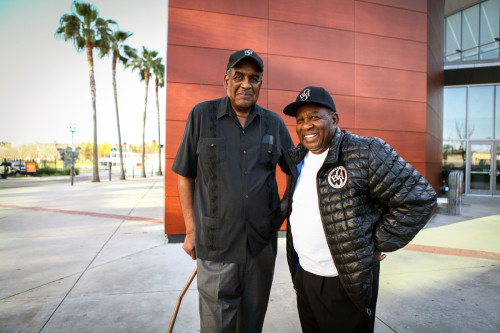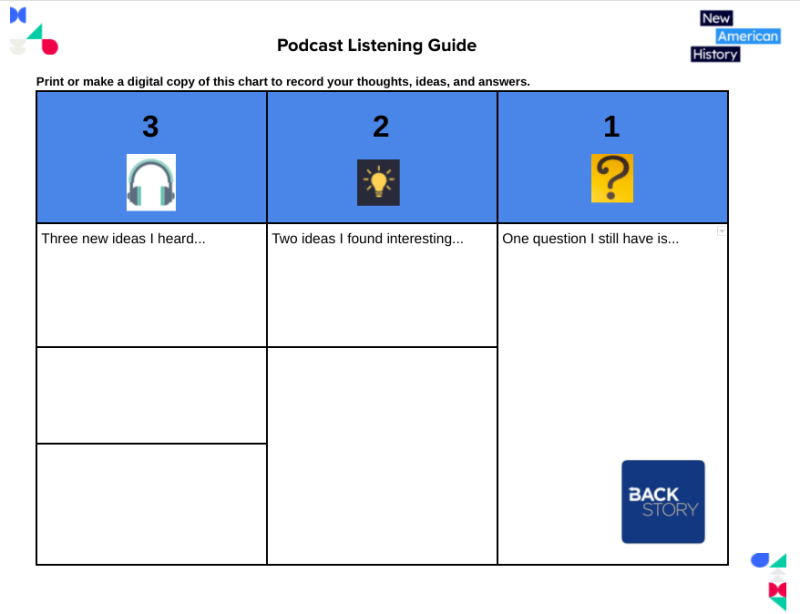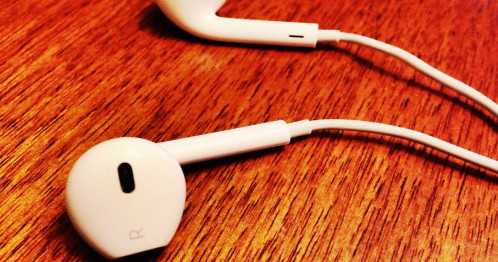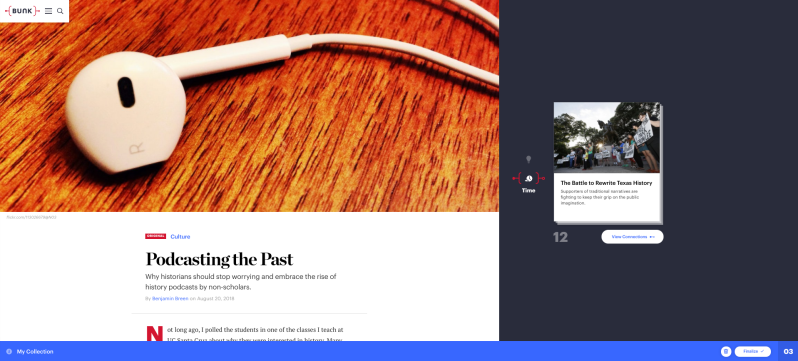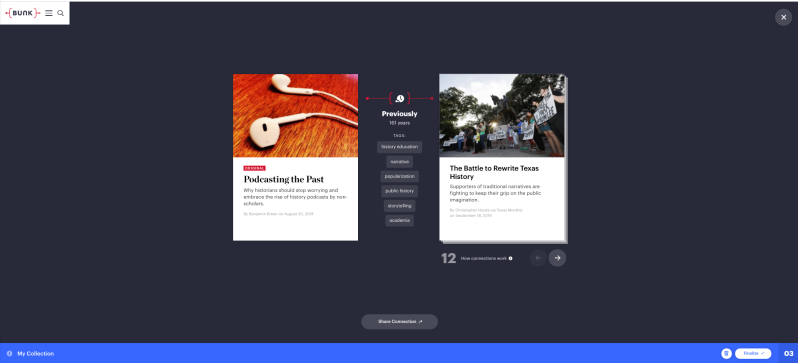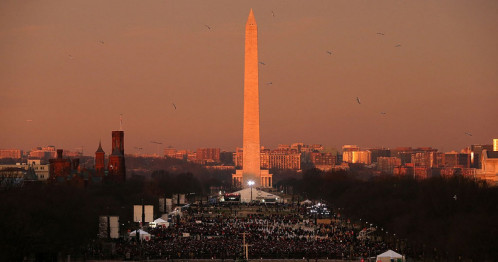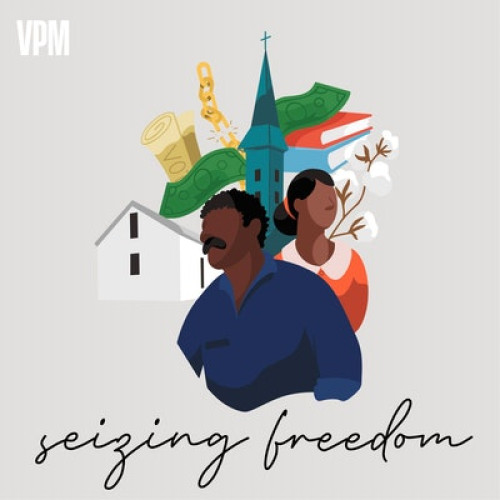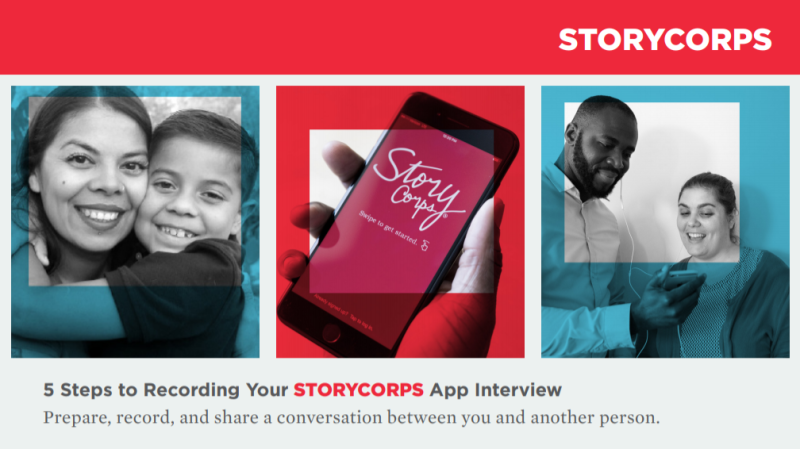This work by New American History is licensed under a Attribution-NonCommercial-ShareAlike 4.0 (CC BY-NC-SA 4.0) International License. Permissions beyond the scope of this license may be available at newamericanhistory.org.
Podcasting History
View Student Version
Standards
Council for Accreditation of Educator Preparation (CAEP)
Standard 1. Content and Pedagogical Knowledge The provider ensures that candidates develop a deep understanding of the critical concepts and principles of their discipline and, by completion, are able to use discipline-specific practices flexibly to advance the learning of all students toward attainment of college- and career-readiness standards. Candidate Knowledge, Skills, and Professional Dispositions
1.1 Candidates demonstrate an understanding of the 10 InTASC standards at the appropriate progression level(s) in the following categories: the learner and learning; content; instructional practice; and professional responsibility.
1.5 Providers ensure that candidates model and apply technology standards as they design, implement and assess learning experiences to engage students and improve learning; and enrich professional practice.
Teacher Tip: The resources provided here help create an open and honest dialogue about the effective use of instructional technology. The resources may be used to build communities of practice amongst pre-service teachers, college university faculty, and K12 educators. They may be used in whole or as part of an online or face-to-face professional learning community (PLC) module. It may help if participants create Group Norms before using these learning resources.
Suggested Audience: Pre-service Educators/K-16 Educators & Professional Learning Communities (PLCs)
Suggested Timeframe: Four 45-minute sessions, or two 90-minute sessions.
Suggested Materials: Internet access via laptop, tablet, or mobile device; earbuds or headphones
Key Vocabulary
Group Norms - Group norms are the spoken or unspoken rules that guide how team members interact, collaborate effectively, and work efficiently.
Professional Learning Community (PLC) - a team of educators who share ideas to enhance their teaching practice and create a learning environment where all students can reach their fullest potential. Most PLCs operate within a school building or across a district.
Podcast - a series of conversational spoken word, musical, or scripted audio episodes, usually focused on a particular topic or theme. You can subscribe to the show and listen to episodes whenever you like, usually on a smartphone, laptop, or tablet. Unlike traditional radio, podcasts may be accessed on-demand via an app or live-streamed via a website.
Read for Understanding
Teacher Tips:
Podcasts are an excellent teaching tool for engaging students and enhancing educators' own content knowledge or professional learning. Podcasts may also be used to help students with disabilties access historical content when traditional textbooks or notetaking strategies are not effective. English Language Learners may benefit from the podcast medium to enhance both listening and speaking skills while learning about history. Podcasts are also ideally suited for remote learning as they may be embedded as links in an LMS such as Canvas or Google Classroom, or a Hyperdoc such as a choiceboard.
This Learning Resource includes language in the body of the text to help adapt to a variety of educational settings, including remote learning environments, face-to-face instruction, and blended learning.
If you are teaching pre-service educators remotely, or working with inservice teachers, consider using videoconferencing to provide opportunities for students and colleagues to work in partners or small groups. Digital tools such as Google Docs and Google Slides may also be used for collaboration.
We welcome your comments, as well as suggestions for additional resources or ideas which we might include to further this discussion. Please feel free to add your thoughts and contributions to this and all of our Learning Resources using our feedback links at the end of each resource.
Engage
How can podcasts engage students in rich historical content?
Pre-listening discussion:
Turn and talk to a neighbor, or if working remotely use the chat feature for video conferencing, or an online forum such as Google Docs or Google Slides to consider each question.
- What is a podcast?
- What topics do podcasts usually explore?
- Where can you hear podcasts?
- Why would you listen to a podcast?
- What’s makes a podcaster different from a YouTube video?
- How does it change the way you tell someone a story when you’re on the phone?
- How does it change the way you listen when you can’t see someone?
One of our favorite sites to explore when you first start using Podcasts is StoryCorps. StoryCorps seeks to preserve and share humanity’s stories in order to build connections between people and create a more just and compassionate world.
The StoryCorps Griot is an initiative to ensure that the voices, experiences, and life stories of African Americans will be preserved and presented with dignity. The Griot Initiative also documents the varied voices of people with roots in the African Diaspora living in the United States.
Named for the traditional storytelling position of honor in West African culture, a Griot (pronounced gree-oh) is a storyteller who remembers and hands down family and community history from one generation to the next.
The StoryCorps Griot recordings are archived at the American Folklife Center at the Library of Congress and in a special collection at the National Museum of African American History & Culture.
Take a few minutes to listen to this episode of The StoryCorps Griot. You may use this Podcast Listening Guide to help guide K12 learners' thinking as they listen. For more information on using podcasts with college aged students, visit How to Listen to a Podcast for Class.
Share your responses with a partner, in the chat or using a reflective journal, or Google Docs or Slides.
- How might you incorporate a podcast like StoryCorps in a future lesson or classroom activity?
- How would you adapt or incorporate a podcast into a lesson designed for remote learning?
When finished, take a few minutes to explore the StoryCorps site. Select another podcast you are interested in hearing. It time permits, share something interesting you learned with a partner.
Explore
Should historians and educators embrace “historically minded” podcasts as a legitimate teaching tool?
History-themed podcasts are amongst the most popular of all genres in the medium. Some, like the pioneering BackStory podcast, are hosted by academic historians. Ed Ayers, Brian Balogh, Joanne Freeman and Nathan Connolly brought their expertise from across multiple eras as they explored topics in the news with a historical lens in a conversational way. Other history podcasts are hosted by journalists, comedians, political pundits, radio or television personalities, and often amateur history enthusiasts. Read this excerpt from Bunk about "Podcasting the Past."
Take a few moments to write in a reflective journal your thoughts about the excerpt you read, and the legitimacy of podcasting as a tool for history education. You may share your thoughts with an elbow partner, or online forum such as Google Docs or Google Slides as directed.
Explore some of the related content on Bunk by selecting an icon (light bulb, clock, map pin, person, etc) or clicking on the View Connections button to the right of the screen. You will now notice two stacks of cards related by a series of tags. For more information about making historical connections, select the How Connections Work button.
- What tags does Bunk generate as you explore more cards?
- How do the tags change as you select each connection?
- How are these cards related to the original excerpt you read about podcasts?
- What tag might you add to the list as a new connection?
You may save these in a Bunk Collection/Assignment to read later or to assign to a class activity. You may also share individual connections using the Share Connection button located at the bottom of your screen. Take a moment to locate an interesting connection to the excerpt of Podcasting the Past, using the tags/icons, and share it with a colleague or classmate.
Note: The team at New American History is constantly adding new content into Bunk, so the connections you see today will often not be the exact same ones you see tomorrow or next week. Just as history is happening all around us every day, Bunk reflects the dynamic historical connections we are constantly making between past and present.
Explain
How can podcasts bring audio storytelling into the humanities classroom?
A 2019 study found that over 50% of people in the U.S. age 12 and up have listened to a podcast. In addition, podcast listening among young people age 12-24 increased 48% from 2017 to 2019.
Podcasts provide a platform for history educators to bring audio storytelling into their classrooms. The use of podcasts in K-12 classrooms enriches the learning process and revitalizes the teaching of humanities topics. Podcasts can bridge the gap between "the history you had to learn, and the history you want to learn." Sometimes they can foreshadow, or add context to historical debates across many generations. Take a few minutes to listen to this excerpt from BackStory, as embedded in Bunk.
When you have finished listening to the segment, Monumental Disagreements, select a more recent excerpt on Bunk using the View Connections button and compare how the thinking on monuments and memorialization has or has not shifted in the local, state or national narrative.
How did the podcast hosts, Ed Ayers and Brian Balogh describe the idea of national remembrance at the time of the original broadcast in 2013?
What do the more recent excerpts or the current national dialogue have in common with this podcast from the BackStory archives?
Take a few minutes to explore the BackStory archives. Select another episode related to the topic of Confederate Monuments and listen to one or more segments.
View the transcripts or a blog post on the BackStory site related to one of the episodes. Select a quote or phrase that gives you pause to think about your own thoughts on the past and current thinking about Civil War monuments and memorials.
Share your quote either with an elbow partner, in a videoconference chatbox, or via a digital forum such as Google Docs and Google Slides. You may also share your quote with us via social media or email at editor@newamericanhistory.org. Be sure to include the episode title and number in your message.
“The thing is that that's always been the case, that the monuments reflect who has the political power. The difference is that the democracy has advanced enough, and means of expression have advanced enough, that the people who are opposed to it have a chance to say something. As somebody who lives in the middle of lots of confederate monuments, we can imagine that they were never welcomed by the African Americans, among whom they were positioned. And they were always there for a political purpose, it just wasn't recognized as such by the white people who controlled all political power.”
Elaborate
How do we encourage students to explore historical narratives through podcasts to understand how the past is connected to issues of social justice in the present?
Our New American History team collaborates with historians, journalists, educators, cartographers, podcast producers, and documentary filmmakers. We seek to bring the most relevant, provocative and honest stories about America to life through audio, visual, digital and print media. Recognizing that digital tools should not be the only platform we provide for students learning historical content, podcasts are a rich source of scholarship, particularly in helping students understand complex and difficult history by humanizing the stories of people who built and shaped America.
Listen to this excerpt from the podcast, Seizing Freedom, which premiered in the fall of 2020.
Using this excerpt of Seizing Freedom and the description of the new podcast, what topics do you anticipate will be explored in the show?
How do the narratives shared in the preview of the podcast differ from traditional curricular materials such as textbooks?
How do you anticipate students will responding to these narratives in audio form?
What scaffolds might you need to embed in your instruction to successfully incorporate a podcast like Seizing Freedom into your instruction?
Here are some of the other history themed podcasts we have discovered and found interesting. Be sure to always listen to a podcast, or view a video in its entirety before introducing it into the classroom. Select a few from the list, along with the excerpts from StoryCorps, BackStory and Seizing Freedom, and create a Choice Board or Hyperdoc for students with a variety of podcast options and learning experiences.
Stuff You Missed in History Class
Have you discovered another terrific history-themed podcast not on our list? We encourage you to share it with us! Follow us on social media (links on our pages). Send us a message at editor@newamericanhistory.org with links to your favorite podcasts and tell us how you use them in your classroom!
Extend
When do we allow students to become producers rather than just consumers of historical content?
Once you and your students become comfortable with digital media including podcasts, video, digital maps and other tools, it is time for them to become the podcast hosts and producers. Student may work in small groups or, if teaching virtually, in monitored breakout rooms to brainstorm possible topics for a 3-5 minute podcast. Research for the content should be a team effort, with students using a variety of primary and secondary sources. Oral histories are great ways to engage the community, including interviewing local veterans, community service providers or local government officials. A local museum or historical society may be most useful for finding a unique angle or surprising story. Select 1 or 2 student hosts, and idenfity 1 or 2 others to write a draft of the script. Most devices come with a voice recorder feature for capturing the dialogue. StoryCorps has step by step directions for students to upload their own stories onto their platform.
Here are some helpful guidelines for student podcasting from National Public Radio. The main thing to remember is podcasts are meant to be heard! Consider contacting a newspaper, radio or television station, or your school division webmaster to see if they might partner with the school and share the student podcasts on their sites (removing any identifying information for safety reasons). Other options include loading student podcast audio files onto a shared Google doc and hosting a listening party at school or remotely.
Note: This learning resource does not include a Google Docs version as it was designed for use with preservice educators and adult learners. Our K-12 learning resources typically include an editable Google Docs version for K-12 educators to make further modifications as needed.



